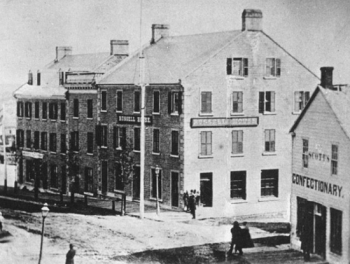8 June 1863
During the late nineteenth and early twentieth century, the centre of Ottawa’s social life was the Russell House Hotel that stood on the southeast corner of Sparks and Elgin Streets. It was a grand and stately hostelry that dated back to about 1845. Originally, the hotel was a three-storey structure with an attic and tin roof known as Campbell’s House after its first owner. Located in Upper Town close to the Rideau Canal, it was the main stopping point for people vising Bytown, later known as Ottawa. Its food and other supplies came from Montreal by river in the summer and overland by sled in the winter.
When Queen Victoria selected Ottawa as the capital of the Province of Canada in 1857, the future of the small community was secured. Its population soared after the Parliamentary and Governmental buildings were completed in the early 1860s, and civil servants and Members of Parliament decamped from Quebec City to Ottawa. Thinking ahead to the business opportunities that this influx of people would bring, Mr James A. Gouin from Quebec City bought Campbell’s Hotel. He renamed it the Russell House after the Russell Hotel in Quebec City where he had worked.
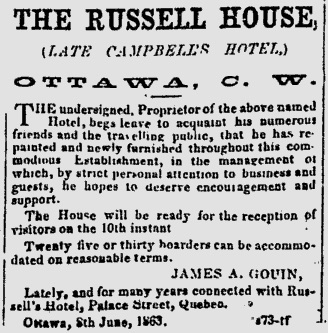 Advertisement, The Ottawa Citizen, 17 July 1863Advertisements dated 8 June 1863 appeared regularly in the Ottawa Citizen through the latter part of that year announcing that Gouin, the new proprietor of the Russell House, had completely repainted and refurnished “this commodious Establishment,” and that “on the 10th instant” would be ready to receive visitors. The hotel could accept twenty five to thirty boarders “at reasonable rates.” The advertisement added that Gouin had been “connected for many years with Russell’s Hotel, Palace Street [Côte du Palais], Quebec.” This hotel, located just a few blocks from the provincial parliament buildings (now the site of Parc Montmorency), had been owned by the Russell family, Americans who had apparently settled in Quebec when it had been the centre of the lumber industry. Gouin later built the Caledonia Springs Hotel, a famous spa in eastern Ontario, and was appointed Ottawa Postmaster by Sir John A. Macdonald.
Advertisement, The Ottawa Citizen, 17 July 1863Advertisements dated 8 June 1863 appeared regularly in the Ottawa Citizen through the latter part of that year announcing that Gouin, the new proprietor of the Russell House, had completely repainted and refurnished “this commodious Establishment,” and that “on the 10th instant” would be ready to receive visitors. The hotel could accept twenty five to thirty boarders “at reasonable rates.” The advertisement added that Gouin had been “connected for many years with Russell’s Hotel, Palace Street [Côte du Palais], Quebec.” This hotel, located just a few blocks from the provincial parliament buildings (now the site of Parc Montmorency), had been owned by the Russell family, Americans who had apparently settled in Quebec when it had been the centre of the lumber industry. Gouin later built the Caledonia Springs Hotel, a famous spa in eastern Ontario, and was appointed Ottawa Postmaster by Sir John A. Macdonald.
Like its namesake at Quebec, the new Russell House Hotel was conveniently located at short stroll from Parliament Hill. It immediately attracted the great and powerful, becoming the home for many Members of Parliament, including Sir John A. Macdonald, in need of a place to live while the House of Commons and Senate were in session. On Confederation Day, 1 July 1867, the Russell House was full, hosting prominent Canadians from across the country who had come to Ottawa to bear witness to that first Dominion Day, now known as Canada Day. Other prominent early guests included George Brown, the fiery Liberal MP. He was apparently staying at the Russell when he penned a complaint to Macdonald regarding the cost of building the Parliament buildings saying: Never mind expenses. Go ahead. Ruin the Country. Stop at nothing. Why not fountains and parks and gardens? It is also believed D’Arcy McGee, the Canadian nationalist and Father of Confederation who was assassinated in 1868 penned some of his poems at the Russell House Hotel.
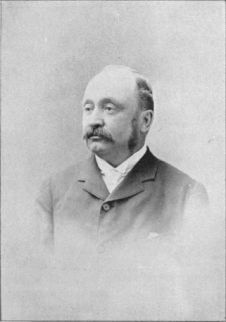 Mr James A. Gouin, First Proprietor and Manager of the Russell House Hotel
Mr James A. Gouin, First Proprietor and Manager of the Russell House Hotel
The Canadian Album, 1895.The hotel was enlarged during the 1870s, with the “New Wing” erected on the Elgin Street side across from the Central Chambers (which still stand today). The hotel’s dining room was located in this wing. In 1880, the original Campbell’s Hotel building was torn down and was replaced by a new, larger, five-storey building on Sparks Street, built in the French Second Empire style, with shops located at ground level. Shortly afterwards, a final extension was made on the east side of the building towards what was then known as Canal Street. (Canal Street disappeared with the building of Confederation Plaza and the extension of the Driveway in 1928.) In the end, the hotel boasted more than 250 rooms.
The hotel reached its peak of popularity during the 1880s and 1890s, and was famous across the country as the place to stay while visiting the nation’s capital. The hotel’s manager, François Xavier St Jacques, who succeeded Gouin, was a living legend. Known as “the Count,” St Jacques was a great eccentric who greeted guests wearing high heel shoes that gave him an odd gait. Visiting Victorian luminaries, such as Oscar Wilde, Lilly Langtry, Lillian Russell, and the boxer “Gentleman” Jim Corbett were Russell House guests. Sir Mackenzie Bowell lived there for seventeen years, including when he was prime minister from 1894 to 1896. Sir Wilfrid Laurier was another long-term tenant, staying at the Russell for ten years before moving to Laurier House in 1897. The hostelry with its long bar and leather chairs was also the site of many political intrigues and debates over the decades, second only to the Parliament buildings themselves.
The Russell House Hotel, synonymous with Ottawa and renowned across the country for elegance and fine dining, was eclipsed by the Château Laurier Hotel when that hotel opened for business a short distance away in 1912. By then, the grand old lady had become worn and shabby. In 1923, several thousand dollars was spent upgrading the main entrance and the rotunda, but it was too little too late. By that point, the hotel was rat and cockroach infested.
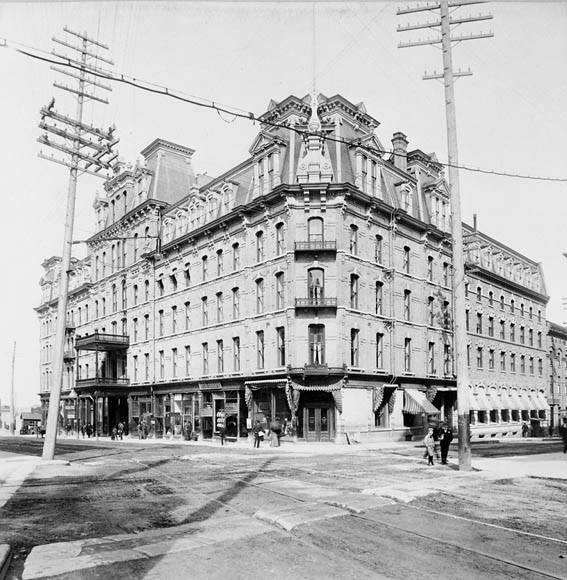 The Russell House Hotel, July 1893
The Russell House Hotel, July 1893
Topley Studio Fonds/Library and Archives Canada, PA-008436.At noon on 1 October 1925, the hotel closed for good, a victim of rising costs and declining occupancy rates. Paradoxically, bookings during the hotel’s last summer had been strong, with the hotel attracting both tourist and convention business; the Russell was the headquarters of the Dominion Trades & Labour Congress that year. But that was not enough to keep the venerable hotel from closing. On its last night, more than 150 guests were booked into the hotel. They had to take “pot luck” for supper in the cafeteria as food supplies were limited. In the rotunda, a number of old timers sat on battered chairs reminiscing about happier times. One hotel veteran was moved by the occasion to pen a poem entitled “Old Russell Farewell.” Its first verse went:
Adieu, adieu old rendezvous
With saddened hearts we’re leaving you;
‘Twas here friends were wont to meet;
Here argued we affairs of state,
How oft’ we talked long and late,
To make the other fellow know.
Ah! Life is but a passing show.
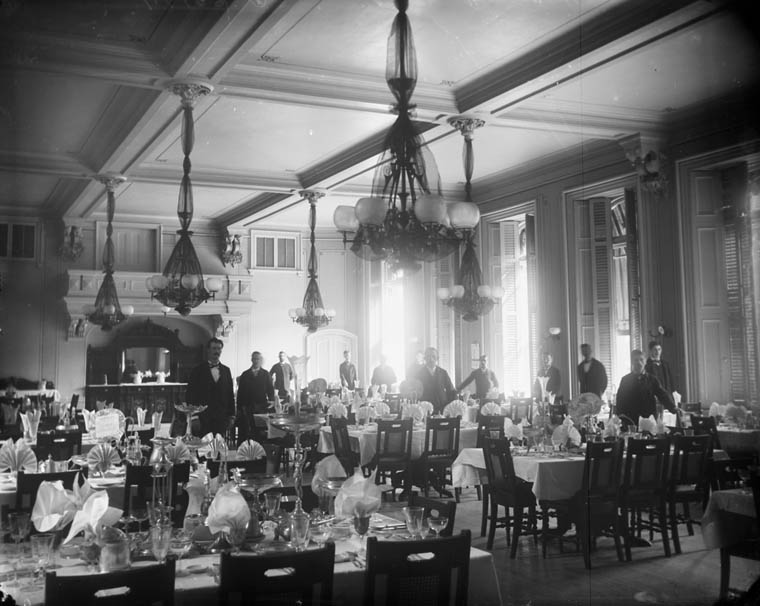 Russell House Hotel Dining Room, May 1884
Russell House Hotel Dining Room, May 1884
Topley Studio/Library and Archives Canada, PA-027059.The next morning, with guests forced to seek their breakfast outside of the hotel, the place was virtually deserted. By shortly after noon, the only employee left out of a staff of 150 was a desk clerk tallying up the last day’s receipts. Gone also were the hotel’s “permanent” residents who had called the hotel home. One had been living at the Russell for thirty-three years.
Initially, its then owner, Russell L. Blackburn, planned to tear down the old hotel and replace it with a modern $1 million hostelry. However, Ottawa City Council balked at his demand to fix his property tax at $7,400 for twenty years. The empty building went into limbo, though the many ground-floor stores continued to operate until the Federal Capital District (FDC), the forerunner of the National Capital Commission, expropriated the Russell block of buildings and torn them down as part of its efforts to beautify the capital. In its place, the FDC built Confederation Plaza in commemoration of the diamond anniversary of Confederation in 1927.
The FDC bought the hotel property and the adjacent Russell Theatre property for $1,270,379.15 (equivalent to roughly $17.7 million in today’s money). The deal was still incomplete when just before midnight on 14 April 1928, the hotel went up in flames in a massive fire. Virtually all of Ottawa’s available fire equipment, which at the time was still being pulled by horses, were called in to tackle the blaze. Five firemen were injured by falling debris and flying glass. The cause of the fire was never ascertained. There was a suspicion of arson as first responders found fires in various places on different floors. However, the fire marshal speculated that had the fire been due to an electrical fault, the fire could have easily spread through the walls and floors before the alarm was called in. Alternatively, the evening’s high winds could have carried embers from floor to floor through the hotel’s many broken and open windows.
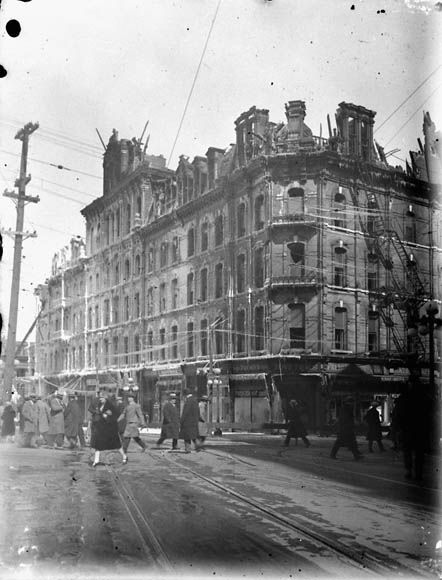 Russell House Hotel after the fire, 1928,
Russell House Hotel after the fire, 1928,
Samuel J. Jarvis/Library and Archives Canada, PA-025085.Thousands of Ottawa citizens watched the firemen fight the blaze. Many were in evening clothes having just left parties and dances. Guests at the Château Laurier Hotel located across Connaught Plaza from the Russell watched the fire from the windows of their rooms. Other spectators arrived by car, with the best parking spots on Parliament Hill near the East Block. There, people watched in the comfort of their heated automobiles. Knowing that the building was slated for demolition, people cheered as the fire progressed. It reached its height at about 2.30am when the flag pole over the central entrance succumbed to the flames. At 4am, more than a thousand hardy spectators were still on hand despite the cold. The firemen were able to contain the blaze, and stop the conflagration from spreading to other structures. At one point Ottawa’s City Hall further down on Elgin Street was threatened. Ironically, the City Hall was to be destroyed by fire three years later.
Losses from the Russell Hotel fire were relatively modest given the scale of the blaze. The Hotel was insured for only $30,000, the low amount reflecting the fact that it was almost derelict and had been emptied of its contents. Some of the small, street-levels shops were not so lucky. “The Treasure House” owned by Herbert Grierson, which sold jewellery, pottery, paintings, china and leather goods, suffered losses of $15,000-$20,000, of which only $8,000 was covered by insurance. The Premier Hat Company lost $10,000 in stock but carried only $2,500 in insurance. Looters also walked off with dozens of hats; one was seen carrying seventeen. Although the owner, Mr Samuel Gluck, was on hand, he was unable to rescue his stock in time owning to difficulty in obtaining a moving truck. Eighteen crates of Persian and Chinese carpets worth $90,000 were also stored in the former cafeteria of the Russell on Elgin Street awaiting auction. Fortunately, the carpets escaped with only minor water damage. They were disposed of in a “fire sale” held a few days later.
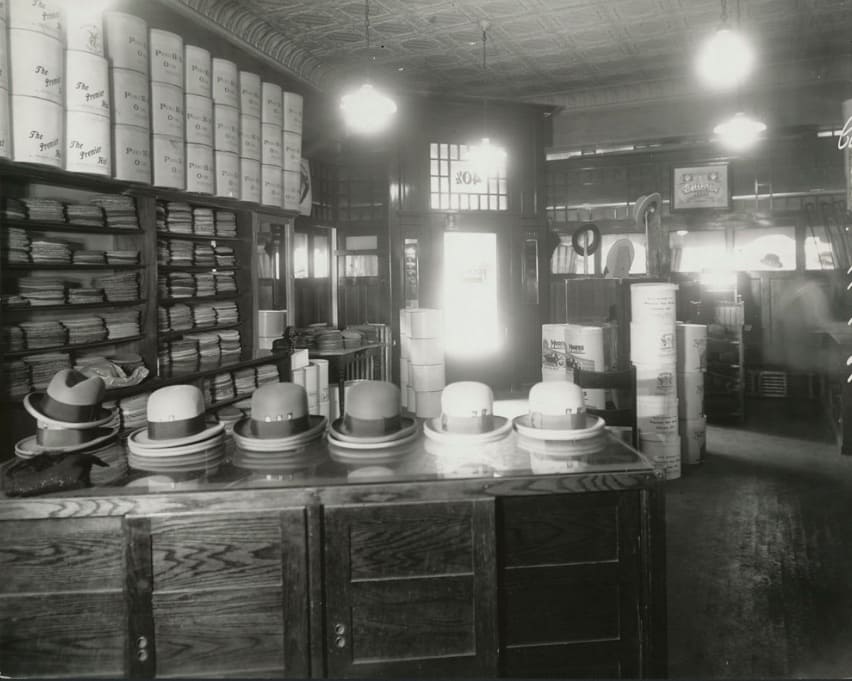 The Premier Hat Company before the fire, 1928
The Premier Hat Company before the fire, 1928
Library and Archives Canada, Mikan 4821789.With the hotel ruined, the authorities moved to clear the rubble. It took longer than expected with the city threatening legal action against the wrecking company if it didn’t hurry up. But at precisely 1.06 pm on Saturday 10 November 1928 the grand old Russell House Hotel, which had been the focal point of Ottawa social and political life for over sixty years, entered history. The last remnant to go was its 80-foot chimney. Recognizing the historic nature of the event, A. Brahinsky, a representative of City Iron & Bottle Company, announced the time of the pending demolition to allow citizens to come and watch the spectacle. Hundreds cheered as the chimney crash to the ground, brought down by heavy cables and a horse truck. There must have been a few tears, however. The Ottawa Journal commented that “there must be many among us who, as one by one the old landmarks go, feel little but loss of happy reminders of a brave and gracious past.”
Today, no trace of the old Russell House Hotel remains. The site of the hotel is now occupied by the War Memorial.
Sources:
Cockrane, William, Rev., 1895. The Canadian Album. Men of Canada; or Success by Example in Religion, Patriotism, Business, Law, Medicine, Education and Agriculture, Bradley Garretson & Co: Brantford,
Evening Journal (The), 1924. “Fixed Hotel Assessments,” 2 October.-
—————————, 1925. “Reached No Decision Over Hotel Request, 23 January.
—————————, 1925. “New Russell House Is Going Out Of Business After Being In Operation Over 50 Years,” 1 September.
—————————, 1925. “Russell Hotel Comes To An End Of Long Career,” 1 October.
—————————, 1928. “Five Firemen Hurt When Russell Block Is Prey To Flames,” 16 April.
—————————, 1928. “Russell Hotel For 60 Years Past An Intimate Part Of City Life,” 16 April.
—————————, 1928. “Demolish Russell,” 9 November.
—————————, 1928. “Hundreds Watch Demolition of Big Chimney At Russell,” 12 November.
—————————, 1928. “The Old Russell House: Some Memories,” 13 November.
—————————, 1934. “Understanding Shown In Letters Between King, Ministry and Ottawa Concerning Beautification of City, 6 January.
Ottawa Citizen (The), 1863. “Russell House,” 17 July.
————————-, 1925. “Russell Hotel Closes Doors: Passing of Historic Hotel Is Devoid Of Any Ceremony,” 1 October.
————————-, 1928. “Fire Will Help Park Scheme To Pass Commons,” 16 April.
Story written by James Powell, the author of the blog Today in Ottawa's History.
Retired from the Bank of Canada, James is the author or co-author of three books dealing with some aspect of Canadian history. These comprise: A History of the Canadian Dollar, 2005, Bank of Canada, The Bank of Canada of James Elliott Coyne: Challenges, Confrontation and Change,” 2009, Queen’s University Press, and with Jill Moxley, Faking It! A History of Counterfeiting in Canada, 2013, General Store Publishing House, Renfrew, Ontario. James is a Director of The Historical Society of Ottawa.



